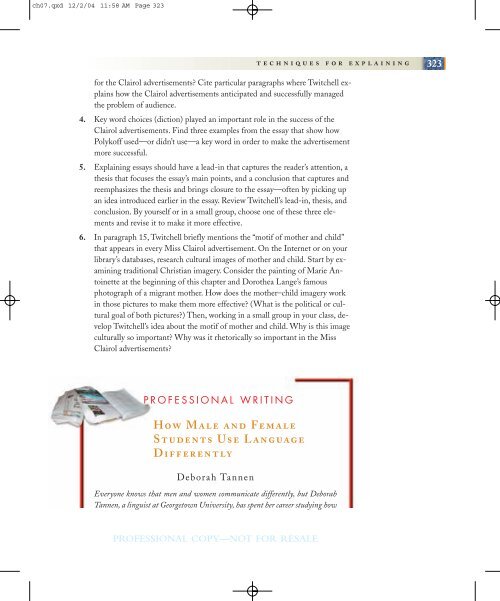A prolific painter of portraits before and after the French Revolution ...
A prolific painter of portraits before and after the French Revolution ...
A prolific painter of portraits before and after the French Revolution ...
You also want an ePaper? Increase the reach of your titles
YUMPU automatically turns print PDFs into web optimized ePapers that Google loves.
ch07.qxd 12/2/04 11:58 AM Page 323<br />
techniques for explaining<br />
323<br />
for <strong>the</strong> Clairol advertisements? Cite particular paragraphs where Twitchell explains<br />
how <strong>the</strong> Clairol advertisements anticipated <strong>and</strong> successfully managed<br />
<strong>the</strong> problem <strong>of</strong> audience.<br />
4. Key word choices (diction) played an important role in <strong>the</strong> success <strong>of</strong> <strong>the</strong><br />
Clairol advertisements. Find three examples from <strong>the</strong> essay that show how<br />
Polyk<strong>of</strong>f used—or didn’t use—a key word in order to make <strong>the</strong> advertisement<br />
more successful.<br />
5. Explaining essays should have a lead-in that captures <strong>the</strong> reader’s attention, a<br />
<strong>the</strong>sis that focuses <strong>the</strong> essay’s main points, <strong>and</strong> a conclusion that captures <strong>and</strong><br />
reemphasizes <strong>the</strong> <strong>the</strong>sis <strong>and</strong> brings closure to <strong>the</strong> essay—<strong>of</strong>ten by picking up<br />
an idea introduced earlier in <strong>the</strong> essay. Review Twitchell’s lead-in, <strong>the</strong>sis, <strong>and</strong><br />
conclusion. By yourself or in a small group, choose one <strong>of</strong> <strong>the</strong>se three elements<br />
<strong>and</strong> revise it to make it more effective.<br />
6. In paragraph 15, Twitchell briefly mentions <strong>the</strong> “motif <strong>of</strong> mo<strong>the</strong>r <strong>and</strong> child”<br />
that appears in every Miss Clairol advertisement. On <strong>the</strong> Internet or on your<br />
library’s databases, research cultural images <strong>of</strong> mo<strong>the</strong>r <strong>and</strong> child. Start by examining<br />
traditional Christian imagery. Consider <strong>the</strong> painting <strong>of</strong> Marie Antoinette<br />
at <strong>the</strong> beginning <strong>of</strong> this chapter <strong>and</strong> Doro<strong>the</strong>a Lange’s famous<br />
photograph <strong>of</strong> a migrant mo<strong>the</strong>r. How does <strong>the</strong> mo<strong>the</strong>r–child imagery work<br />
in those pictures to make <strong>the</strong>m more effective? (What is <strong>the</strong> political or cultural<br />
goal <strong>of</strong> both pictures?) Then, working in a small group in your class, develop<br />
Twitchell’s idea about <strong>the</strong> motif <strong>of</strong> mo<strong>the</strong>r <strong>and</strong> child. Why is this image<br />
culturally so important? Why was it rhetorically so important in <strong>the</strong> Miss<br />
Clairol advertisements?<br />
PROFESSIONAL WRITING<br />
How Male <strong>and</strong> Female<br />
Students Use Language<br />
Differently<br />
Deborah Tannen<br />
Everyone knows that men <strong>and</strong> women communicate differently, but Deborah<br />
Tannen, a linguist at Georgetown University, has spent her career studying how<br />
PROFESSIONAL COPY—NOT FOR RESALE

















